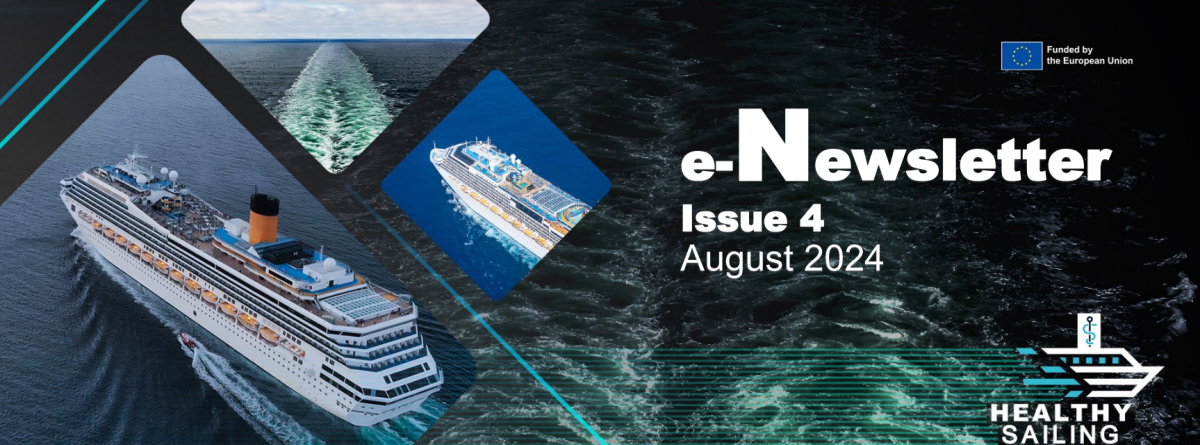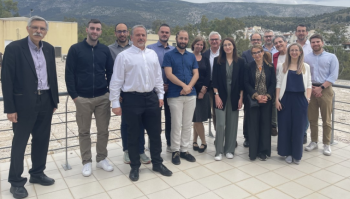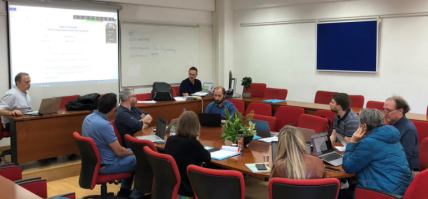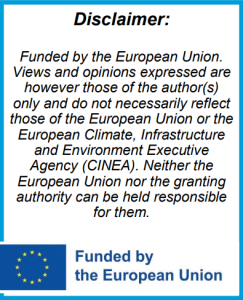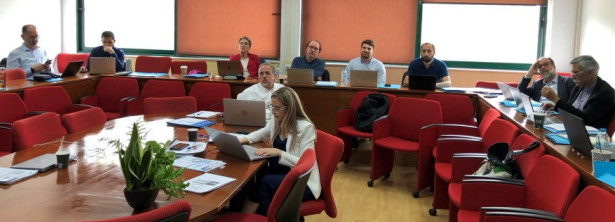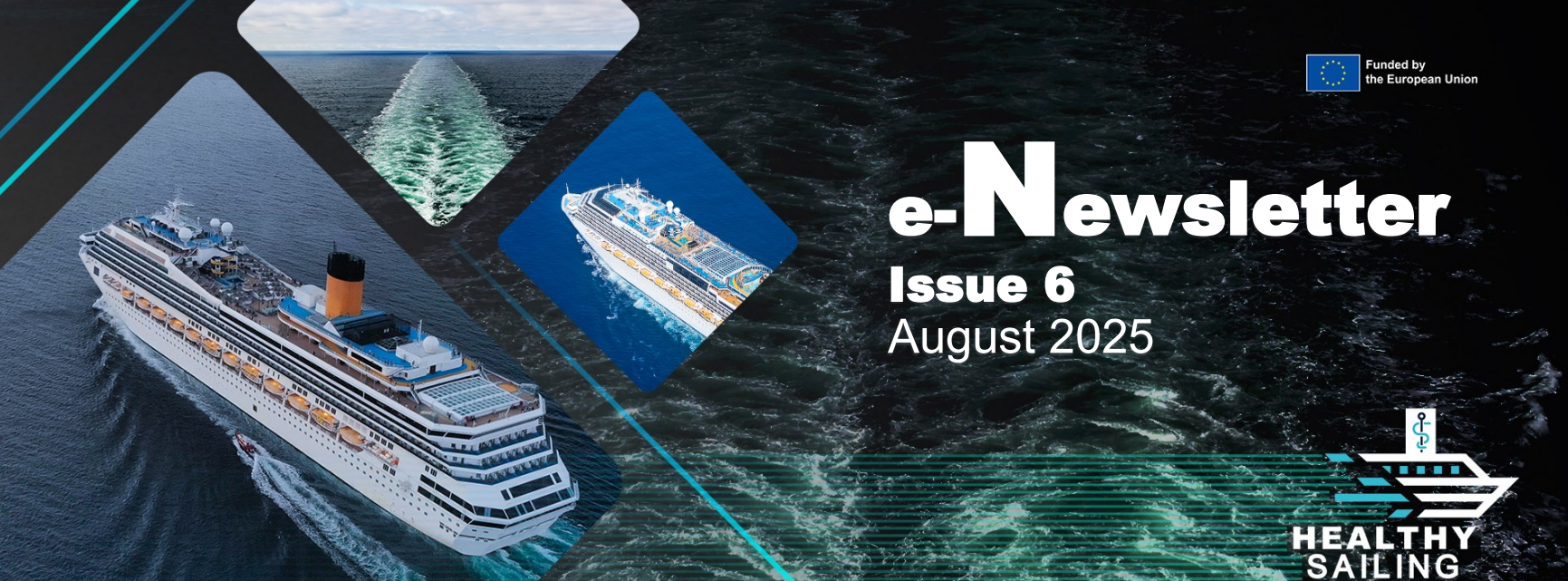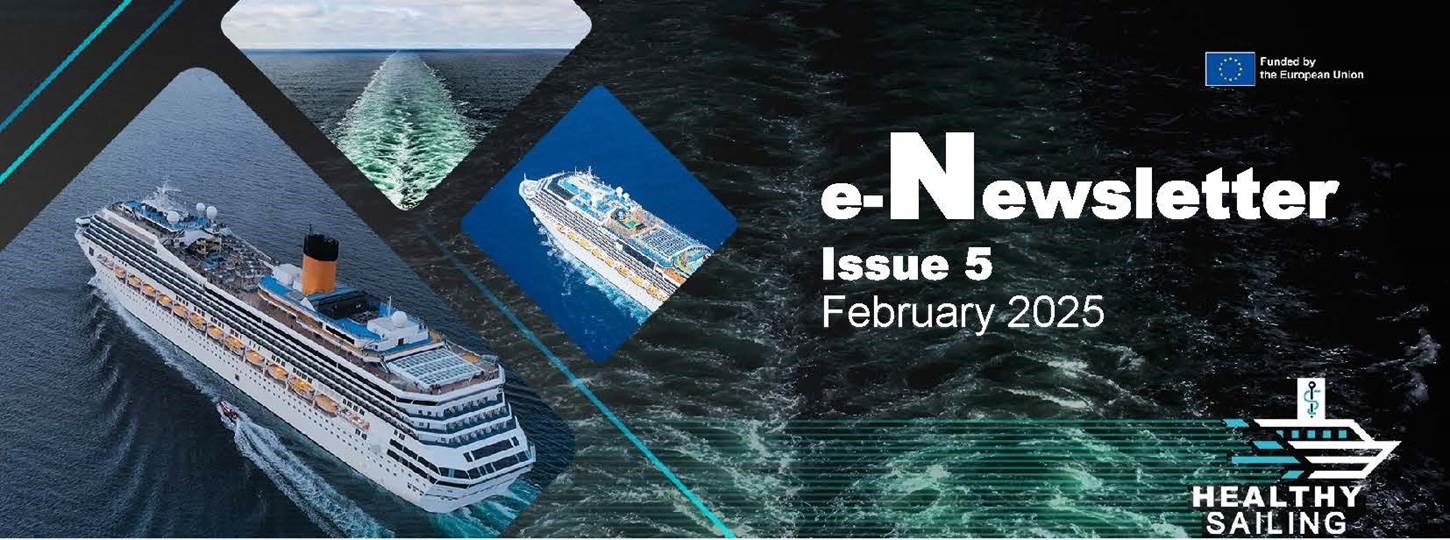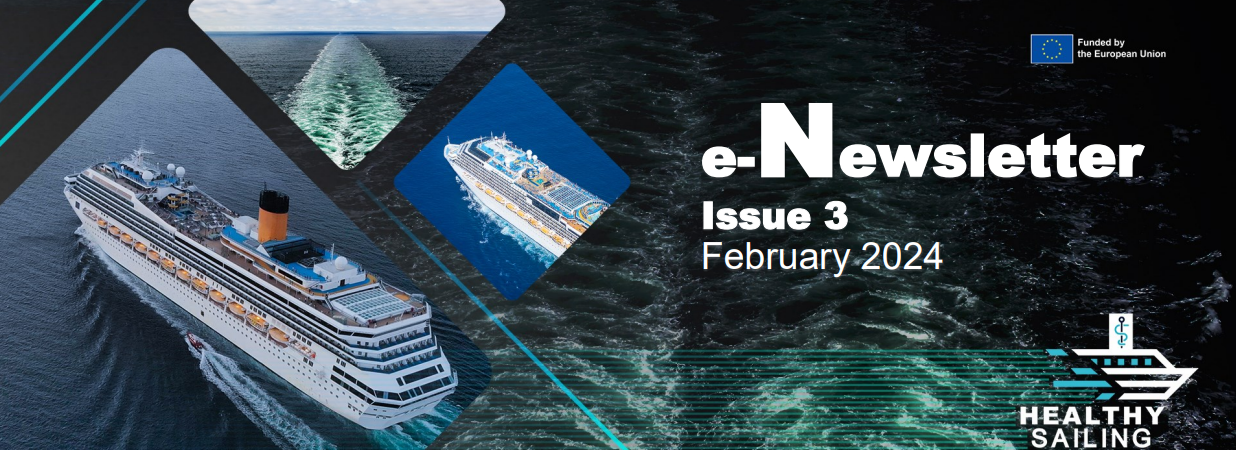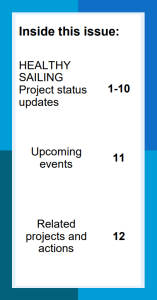
HEALTHY SAILING Project Status Update
Updates from the Coordination
Over the next months, the coordination team at University of Thessaly (UTH) is focusing on theorganisation of the next General Assembly meeting, scheduling internal webinars for thepartnership, and coordinating a Round Table dedicated to HEALTHY SAILING at the “Public Health Congress on Maritime Transport and Ports 2024: Innovations in infectious diseasescontrol and occupational health” which will take place on 18-19 October 2024 (hybrid event).Moreover, UTH is facilitating the planning and implementation of intervention studies, pilot-testsand technological demonstrations, by ensuring access to cruise ships and smooth execution ofthe research protocols.
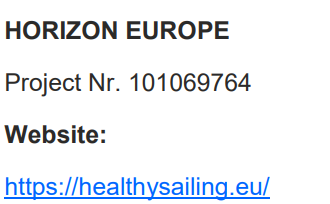 Interim Periodic Report and Review Meeting
Interim Periodic Report and Review Meeting
UTH coordinated the preparation and submission of the interim report, including an update on progress towards achieving the project’s three specific objectives (read about the specific objectives here). The process was completed with an interim review meeting on 14 May 2024, providing an excellent opportunity for partners to unite online and in person in Athens, Greece, showcasing the project’s progress and results to the CINEA project officer. A total of 28 participants joined in — 19 in person and 9 remotely. The following day (15 May 2024),HEALTHY SAILING partners delved into the outcomes of the recent review meeting. Participating researchers discussed upcoming work plans and linkages between the HEALTHY SAILING tasks. This collaborative session offered a chance to strengthen partnerships and chart a course forward for the remaining tasks.
NEWSLETTER SUBSCRIPTION
Subscribe to the HEALTHY SAILING eNewsletter: https://healthysailing.eu/category/newsletters/
If you are already subscribed to our newsletter and you would like to unsubscribe, you may do so by clicking here or by sending us an email to the following address: it[at]healthysailing.eu
This is a biannual publication of the HEALTHY SAILING project. Next issue: February 2025
Follow us on Social Media:
LinkedIn
Twitter
Facebook
YouTube
ResearchGate
Project Status Update

Updates from the Coordination
Collaboration with the HS4U consortium
• A “Principles of Collaboration” document was finalized and accepted by both consortiums, describing potential areas of collaboration.
• During a hybrid meeting on 13 May 2024, HEALTHY SAILING joined forces with the HS4U project to present the joint activities to the CINEA project officer.
•The first joint technical working group was organised on 22 July 2024. The purpose of the meeting was for the two consortium to explore possible synergies. Collaboration will continue over the next months.
Inventory of diagnostic laboratory methods for infectious agents
Healthy Sailing developed an inventory of diagnostic laboratory methods for infectious agents. The purpose was to: 1) identify existing methods for laboratory diagnosis of infectious agents and characterize their performance (accuracy and reliability) and feasibility use onboard large passenger ships, and 2) create a reference document presenting currently available methods that would support passenger ship operators with planning and decision making about diagnostic supplies to use onboard. Read more at page 9.
Online repository of HEALTHY SAILING data collection tools
UTH developed an online repository to compile existing data collection tools developed through various HEALTHY SAILING tasks, such as survey questions, focus groups discussion templates. These tools will be available to partners for future project tasks. Only data collection tools that have been peer-reviewed and received approval from the consortium partners and passenger ship industry are included in the repository. This repository will be internal and only available to consortium partners.
Status of project deliverables and tasks
As of August 2024, a total of 17 out of 35 project deliverables have been submitted, while 5 out of 7 milestones have been achieved. The completion percentage of work packages is nearly 50% for 6 of the 7 project work packages. During the first reporting period (September 2022 to February 2024), nearly 200 technical and scientific meetings (internal and external) were conducted.
No. Deliverable Name
D1.1 Project quality assurance & management plan
D2.1 Data management plan
D2.2 Interim dissemination & exploitation plan
D3.1 Foundation report for COVID-19 related preliminary results
D3.2 Report from intervention studies & pilot-runs (first version)
D3.3 Report on computational modelling of droplet and aerosol dispersion (validation data report)
D3.4 Evidence-based guidelines (COVID-19 interim guidelines)
D3.5 Foundation report (revised version)
D3.8 Report on computational modelling of droplet and aerosol dispersion (model validation report)
D4.1 Procedures for syndromic surveillance
D4.2 Integrated e-surveillance system for health threats (first version)
D5.2 Artificial Intelligence Water Safety Plan (first version)
D5.3 Inventory of diagnostic laboratory methods
D6.2 Terms of reference – International expert panel
D7.2 Blended Learning training toolkit enriched with hands-on training (HOT) – first version for COVID-19 module
D7.4 Study Initiation Package
D7.5 Midterm recruitment report
Publications, Dissemination & Communication activities
Article in journal
Interventional Study of Nonpharmaceutical Measures to Prevent COVID-19 Aboard Cruise Ships
Mouchtouri VA, Kourentis L, Anagnostopoulos L, Koureas M, Kyritsi M, Kontouli KM, Kalala F, Speletas M, Hadjichristodoulou C.
Emerg Infect Dis. 2024 May;30(5):1030-1033. doi: 10.3201/eid3005.231364. PMID: 38666667; PMCID: PMC11060450.
Abstract
Cruise ships carrying COVID-19–vaccinated populations applied near-identical nonpharmaceutical measures during July– November 2021; passenger masking was not applied on 2 ships. Infection risk for masked passengers was 14.58 times lower than for unmasked passengers and 19.61 times lower than in the community. Unmasked passengers’ risk was slightly lower than community risk.
Read full article here
Article in journal
Systematic literature review and meta-analysis on preventing and controlling norovirus outbreaks on cruise ships, 1990 to 2020: calling for behaviour changestrategies of travelers
Mouchtouri Varvara A, Simou Evangelia, Soteriades Soteris, Rousou Xanthoula, Kontouli Katerina Maria, Kafetsouli Dimitra, Kourentis Leonidas, Anagnostopoulos Lemonia, Hadjichristodoulou Christos.
Euro Surveill. 2024;29(10):pii=2300345. https://doi.org/10.2807/1560-7917.ES.2024.29.10.2300345
Abstract
Background: Outbreaks of norovirus gastroenteritis aboard cruise ships may affect a large number of people, debilitate vulnerable travellers, disrupt vacations and cause economic losses to the cruise ship industry. Aim: We aimed to identify risk factors for norovirus outbreaks on cruise ships and assess the effectiveness of prevention and control measures. Methods: We conducted a systematic literature review searching PubMed and Scopus databases as well as grey literature for articles and reports describing norovirus outbreaks on cruise ships between 1990 and 2020. We also performed a meta-analysis of norovirus prevalence in passengers and crew members. Results: Data from 45 outbreaks on 26 cruise ships from 1990 to 2020 were identified in 13 articles and five reports, with a weighted average of prevalence (attack rate) for passengers of 7% (95% confidence interval (CI): 5.00–9.00) and for crew of 2% (95% CI: 0.00–3.00). Person-to-person was the most frequent mode of transmission in 35 of the 45 outbreaks (in 14 the only mode and in 21 as part of multiple transmission routes). Having an ill cabin mate (OR = 38.70; 95% CI: 13.51–110.86) was the most common risk factor. Six outbreak investigations reported poor hygiene, while four reported satisfactory hygiene in the cruise setting. Behavioural risk factors among travellers were investigated in three of the 13 studies. Conclusions: The findings indicate a need for behavioural interventions to improve personal hygiene, symptom reporting and compliance with isolation measures, and for reconsidering current isolation policies where symptomatic and healthy individuals are isolated in the same cabin.
Read full article here
Article in journal
The Effectiveness of Far-UVC Radiation in Public Spaces: A Case Study in Elevators
Bansaghi S, Klein J.
Infection Prevention in Practice, https://doi.org/10.1016/j.infpip.2024.100390.
Abstract
Background: Using far-Ultraviolet-C (UVC) radiation with an emission maximum of 222 nm, has the potential to kill bacteria while not being harmful to humans and can be used continuously in public areas. Elevators pose a high risk of infection transmission, as they are small, crowded spaces with poor ventilation. In such a setting continuous decontamination would be very useful. This study aimed to measure the effectiveness of a far-UVC lamp installed in a frequently used elevator by comparing the bacterial load found in that elevator with the bacterial load in a control elevator. Methods: Microbial load was measured by different methods; ATP bioluminescence, surface samples were collected by contact slides, contact plates, and swabbing. Air samples were also collected. Results: No significant differences were found in the microbial content between the control elevator and the UV lamp elevator, regardless of whether the UV-lamp was always on, or was used with a motion sensor to turn off when someone entered the elevator. Conclusions: The results suggest that the far-UVC requires a longer time to kill the bacteria, while the people traffic were continuously re-contaminating the elevators.
Read full article here
Presentation of the toolkit for technology induced behavioural change in hand hygiene (Task 7.1)
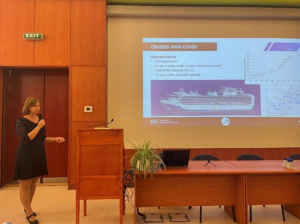 Task 7.1 was presented in a Hungarian hand hygiene conference, organized by the National
Task 7.1 was presented in a Hungarian hand hygiene conference, organized by the National
Health Authority (9 May 2024 in Budapest, Hungary at the National Centre for Public Health and Pharmacy). Participants mostly came from healthcare backgrounds. Under Task 7.1, partners from USN investigated the hand hygiene behavior of cruise ship passengers. Conclusions from the study could be of interest to the healthcare sector, where visitors—who are just as much laypeople as passengers—play an important role in infection transmission, and their hand hygiene practices also need improvement.
HEALTHY SAILING at the Transport Research Arena (TRA) 2024 Conference
The HEALTHY SAILING project was presented during the Transport Research Arena (TRA) 2024 Conference held in Dublin, Ireland in April 2024. TRA is a prestigious European transport event that covers all transport modes and all aspects of mobility. Prof. Nikolaos P. Ventikos from NTUA represented the project at the WaterborneTP stand, while also delivering a flash presentation for our poster!
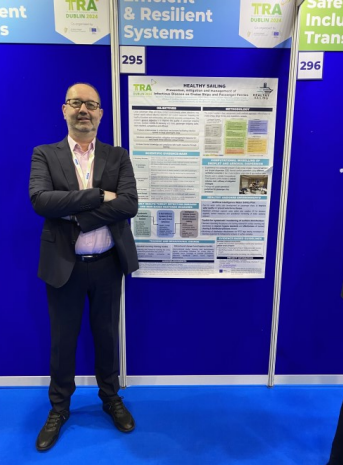
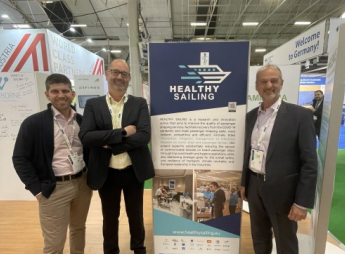
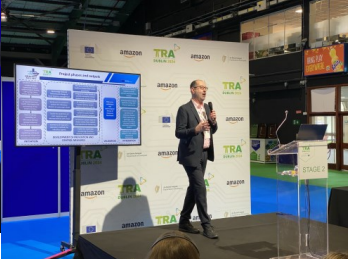

Website and Social Media Analytics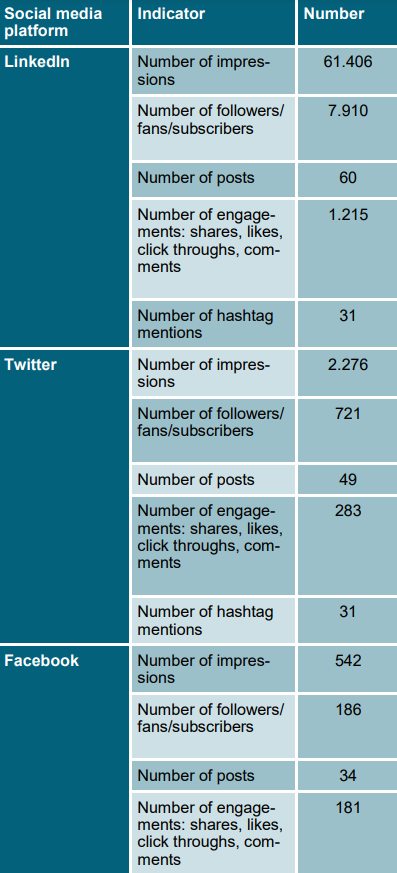
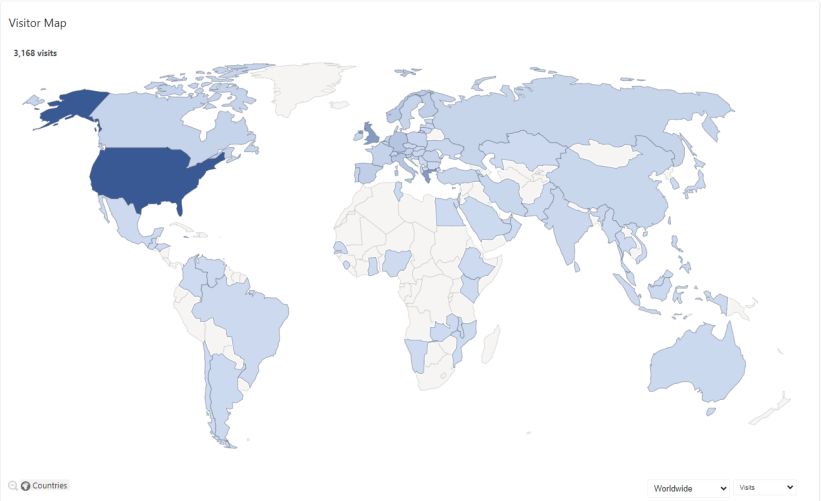
Website analytics
Since the launch of the HEALTHY SAILING
website in November 2022,
6,325 page views &
3,168 visits
have been recorded.
Social media analytics
The numbers of followers, impressions and engagements have increased on HEALTHY SAILING social media accounts, particularly for LinkedIn. The project remains active on all platforms, and based on the analytics, it is evident that LinkedIn is the preferred media channel for stakeholders to stay informed about the project’s news (Figure 1 and Table 1). A total of 6 videos are posted on the HEALTHY SAILING YouTube channel, which have 161 views as of August 2024.

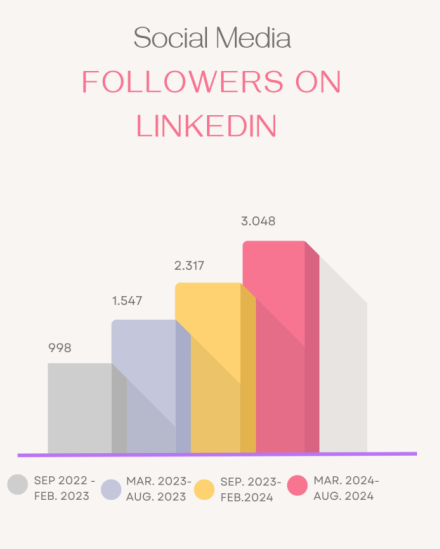
Systems and prototypes for early threat detection and decision support onboard (Tasks 4.1-4.4)
A Syndromic Surveillance System for infectious diseases was created by HEALTHY SAILING partners (UTH, UKE, ISCIII, ISS) providing a systematic, regular and uniform approach to surveillance on passenger ships (Deliverable 4.1). Designed to identify trends in space and time for early outbreak identification, the system improves the quality of surveillance for all communicable disease types, promoting early threat detection on board. The system was pilot-tested using historical data and by obtaining feedback from end-users, to ensure interoperability with existing ship operational aspects. The Syndromic Surveillance System has been incorporated as an input source for the integrated ESurveillance System for health threats (E-SS) developed by ICCS. The purpose of E-SS is to facilitate early health threat detection on board. The design of ESS provides an integrated system collecting input including demographic data, voyage data and medical information (ship medical and surveillance logs). E-SS outputs have been defined to meet legislative and operational needs of passenger ship companies for syndromic surveillance, facilitating uptake of E-SS by endusers. These outputs provide epidemiological information (rates, curves for each disease) for early outbreak identification, and documents to be used by ship companies for reporting to the next port of call. Outputs of E-SS along with inputs from on board environmental monitoring and land-based epidemiological information will provide input to the Artificial Intelligence Intelligent Immune System (AI-IIS) developed by NKUA. This prototype serves as a central hub for realtime awareness and health measure decision-making. Based on continuous real-time assessment of risks, the system will recommend specific health measures for varying risk levels, tailored to different user groups such as crew members, passengers and specialized staff.
Preventing waterborne disease on board using artificial intelligence (Task 5.4)
A preliminary version of a Water Safety Plan (WSP) tool has been developed by HEALTHY SAILING partners (NKUA and SHIPSAN), intended to provide decision support to simplify the process of WSP development, improve water quality and prevent waterborne diseases on board passenger ships (Deliverable 5.2). A situational analysis of the current framework in water safety produced evidence which transformed current knowledge into rules, algorithms and models, used to develop this version of the software decision support tool. The first version of the prototype provides a structured approach guiding users through nine detailed steps of developing a water safety plan based on the World Health Organization (WHO) methodology, assisting with risk assessment by providing a list of possible hazard events and pre-specified risk assessment values. In the initial implementation phase during the first reporting period, the prototype supports the first six steps of the WHO methodology. The prototype will be pilot tested as part of an intervention study, in which the intervention ship will develop a Water Safety Plan from scratch with the assistance of the tool. The study will evaluate the tool’s effectiveness in aiding the development of a comprehensive WSP that identifies all hazardous events on board.
Toolkit for systematic monitoring of surface cleaning and disinfection: improving on board cleaning and disinfection of cabin areas and public restrooms (Task 5.2)
HEALTHY SAILING is developing a toolkit to enhance hygiene practices on board passenger ships. As part of this toolkit, Standard Operating Procedures (SOPs) have been developed for housekeeping personnel, defining their responsibilities, required equipment and supplies, and detailed procedures for cleaning and disinfecting public toilet and cabin areas on board. Training materials are also being developed to facilitate housekeeping personnel with implementing these novel SOPs. Both the SOPs and training material have been integrated into an intervention study assessing the toolkit’s effectiveness in enhancing the quality of cleaning and disinfection procedures on board. During the intervention study, environmental surface and hand samples will be collected from both an intervention ship and control ship, with laboratory analysis conducted at UTH. Meanwhile, cleaning processes will be monitored based on predefined key performance indicators. The intervention study commenced on 11 July 2024, when a team from UTH boarded the MSC Sinfonia (intervention ship) docked at Piraeus port. During this initial site visit, preliminary work was conducted to prepare for the intervention study. The team will regularly board the intervention ship during its calls to Piraeus port until December 2024. On 18 July 2024, the HEALTHY SAILING team again embarked the MSC Sinfonia in Piraeus port. During this visit, the UTH team practiced implementing the HEALTHY SAILING SOPs for cleaning and disinfection of cruise ship cabins. During this practice-run, the UTH team focused on determining the quantity of disinfectants needed to ensure different areas and surfaces of the cabin remained wet, achieving proper contact time and ensuring disinfection is effectively conducted. Observing MSC’s cleaning protocols in public area toilets during peak hours also provided valuable insights, that were integrated into the SOPs. A subsequent visit to MSC Sinfonia was conducted on 25 July 2024 by UTH. This visit allowed the team to further practice and perfect the updated SOPs in cabin areas. The team was joined by a videographer and a member of the NKUA team, to observe on board spaces as well as cleaning and disinfection procedures for cabins and public toilets. Each step of the SOPs will be recorded, for use as training material among crew members in the intervention study. In addition to conventional training videos, the NKUA team will develop Augmented Reality (AR) videos of SOP implementation, as an engaging and innovative training material to be included in the HEALTHY SAILING toolkit. With the SOPs for cleaning and disinfection of cruise cabins nearly finalised, the next ship visits on board MSC Sinfonia will focus on recording the training videos and developing AR materials. Moreover, in the coming weeks UTH will visit the MSC Opera (control ship) to collect environmental surface and hand samples from cabin and public toilet areas.
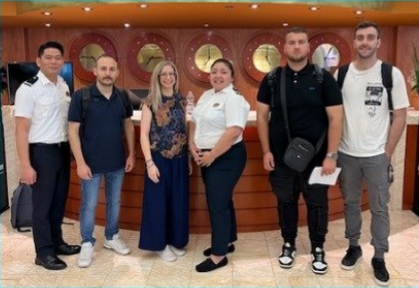
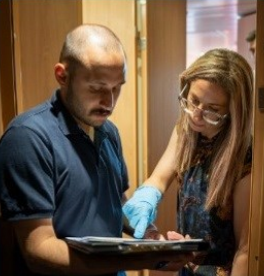
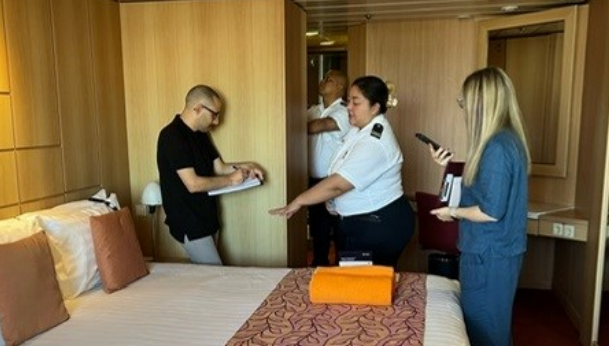
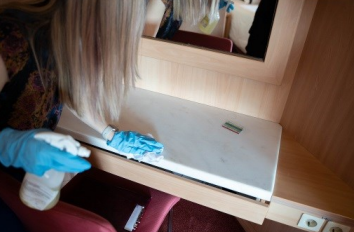


Blended Learning training toolkit enriched with hands-on training – first version for COVID-19 module (Task 7.2 and 7.4)
The project has significantly advanced the development of its blended learning training toolkit (first version for COVID-19 module), integrating augmented reality hands-on-training with a robust e-learning platform (Figure 1). The Blended Learning Training Toolkit is an innovative educational environment for the training of crew members, enriched with augmented reality handson training applications and open education resources available to passengers. In the toolkit’s first version, two courses for COVID-19 PMM are available on the e-learning platform, targeting higher ranking and lower ranking crew members, respectively. The HEALTHY SAILING e-learning platform can be accessed at: https://training.healthysailing.eu/ The courses emphasize understanding infection transmission, recognition of infectious disease symptoms, potential consequences of delaying reporting, and personal protective measures. As part of the Blended Learning Toolkit, a HEALTHY SAILING digital Library has been developed as an online repository to provide access to Open Educational Resources (manuals, guidelines, and informative videos) for passengers and crew to engage in self-directed exploration of topics and continuous learning (Figure 2). At this initial phase, the consortium has collected and uploaded 15 annotated resources. A validation process has been carried out to ensure the quality of the resources.
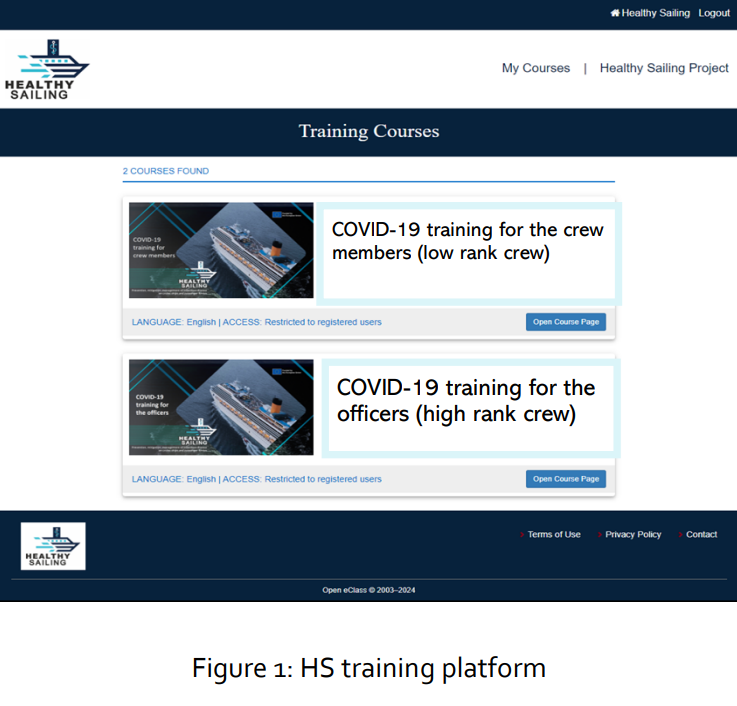
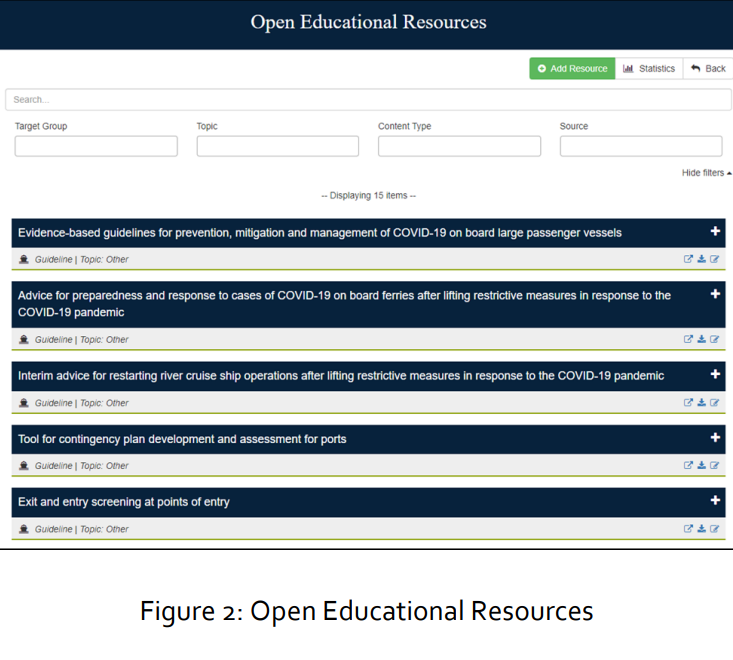
Awareness video for passengers
Considering social, behavioral and cultural aspects identified through KAP surveys and focus groups, an educational animation script was prepared communicating good health practices to cruise passengers; this animation contributes to infectious disease prevention through awareness raising and increasing knowledge about infection prevention and hygiene practices (Figure 3).

Inventory of diagnostic laboratory methods for infectious agents (Task 5.3)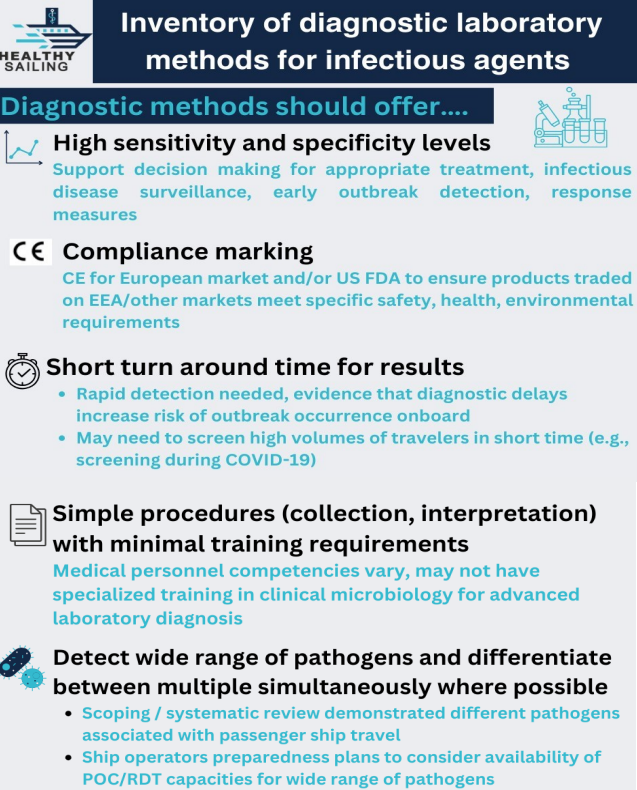
Effective management of infectious diseases in the maritime sector requires accurate fast diagnosis that can be performed on board ships. Healthy Sailing developed an inventory of diagnostic laboratory methods for infectious agents. The purpose was to: 1) identify existing methods for laboratory diagnosis of infectious agents and characterize their performance (accuracy and reliability) and feasibility use onboard large passenger ships, and 2) create a reference document presenting currently available methods that would support passenger ship operators with planning and decision making about diagnostic supplies to use onboard. To focus on infectious agents most relevant to the passenger ship setting, results from the HEALTHY SAILING scoping review and systematic literature review were used. A working group supported the identification and assessment of diagnostic laboratory methods, uniting consortium members with the following expertise: infectious disease epidemiology, clinical and laboratory diagnosis, microbiology, medical operation specificities/needs in passenger ships and passenger ship outbreak. To identify available diagnostic laboratory methods / technologies, three strategies were used: market research of publicly available information; consulting service providers of technologies and products; requesting input from end-users (passenger ship companies participating in the project consortium) about currently used technologies. A list of criteria for assessment of identified technologies was established. The following broad criteria were defined: a) system performance (accuracy, reliability, safety); b) pre-requisite conditions for system operation onboard large passenger ships; c) options/capacities for environmental sampling; d) options for remote monitoring of results ashore by passenger ship company headquarters; e) pilot-testing or current use of technology in a ship environment; f) geographic availability/coverage of the technology; g) commercial availability of the technology; h) cost of the technology; i) technical and scientific support provided for implementation.
 Two groups of diagnostics were considered for inclusion in the inventory: 1) Syndromic point-of-care (POC) technologies for one or more pathogens; 2) Rapid diagnostic tests (RDT) (lateral flow immunochromatographic tests). Pathogens addressed in the inventory include respiratory viruses, gastrointestinal pathogens (viruses, bacteria, parasites), Hepatitis A/B/E, vector-borne diseases (Malaria, Yellow Fever, Zika, Dengue, Chikungunya), Monkeypox Virus, Ebola Virus (Table 1). Information about each syndromic POC test and rapid diagnostic test was extracted where available and relevant, either from public sources or after consultation with respective service providers.
Two groups of diagnostics were considered for inclusion in the inventory: 1) Syndromic point-of-care (POC) technologies for one or more pathogens; 2) Rapid diagnostic tests (RDT) (lateral flow immunochromatographic tests). Pathogens addressed in the inventory include respiratory viruses, gastrointestinal pathogens (viruses, bacteria, parasites), Hepatitis A/B/E, vector-borne diseases (Malaria, Yellow Fever, Zika, Dengue, Chikungunya), Monkeypox Virus, Ebola Virus (Table 1). Information about each syndromic POC test and rapid diagnostic test was extracted where available and relevant, either from public sources or after consultation with respective service providers.

Healthy Sailing Guidelines
The HS working groups will be finalizing in the next months the evidence based guidelines for:
– Guidelines for medical operations in large passenger ships focusing on expedition vessels”
– Guidelines for vaccination of passengers and crew in large passenger ships
Placing project outputs in the context of the social sciences and humanities (SSH)
The consortium will focus on Task 7.5 for the second half of the project –Placing project outputs in the context of the social sciences and humanities (SSH). A working group meeting is planned for September to discuss work progress and future plans for
• cost-benefit analysis of introduced measures (Task 7.5.1),
• communication methods as part of PMM measures (Task 7.5.2),
• safety risk assessment onboard regarding IMO regulations (Task 7.5.3),
• gender analysis in research project outputs (Task 7.5.4),
• standardizing and implementing learning outcomes based in project results (Task 75.5).
Toolkit for technology induced behavioural change in hand hygiene (Task 7.1)
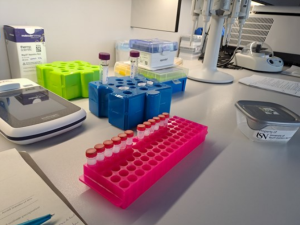
In recent months, we analyzed surface samples collected onboard a cruise ship. Utilizing next generation sequencing, we successfully described the complete microbiome of the examined surfaces. We are now investigating how these microbiomes differ from those found in other environments. Do they exhibit unique characteristics, and if so, are there any public health implications?
Other Upcoming Events EU SHIPSAN CONGRESS
 Join us in person or virtually at the international “Public Health Congress on Maritime Transport and Ports 2024: Innovations in infectious diseases control and occupational health”, organised by the EU SHIPSAN scientific association that will take place on 18-19 October 2024 in the historic city of Naples, Italy.
Join us in person or virtually at the international “Public Health Congress on Maritime Transport and Ports 2024: Innovations in infectious diseases control and occupational health”, organised by the EU SHIPSAN scientific association that will take place on 18-19 October 2024 in the historic city of Naples, Italy.
Governments, industry, and the scientific community work diligently to respond to emerging challenges and opportunities for the attainment of public health protection in the maritime transport sector. The theme of this Congress will provide opportunities to exchange opinions, best practices, current research and innovation activities, as well as results in ports and in all ship types related to infectious disease prevention, mitigation and control; occupational health; maritime healthcare; environmental health and hygiene; and healthy ship design. It is anticipated that the Congress will offer a venue for the shipping industry, academia, governmental officials, port administrations, marine companies, and related stakeholders to explore recent research findings, new scientific evidence, novel innovations and approaches for planning public health actions in the framework of green maritime operations. Healthy Sailing will also be participating with a round table to present their latest research. The congress will provide a great opportunity to network, enjoy and learn from each other. The Congress’ proceeding papers will be published in in the peer-reviewed journal indexed in Scopus, Population Medicine journal.
Register here: https://registrations.shipsancongress2024.eu/
Abstract submission here: https://congressworld-registrationform.gr/abstract-submission-shipsancongress2024/
Related projects and actions
The HS4U project advances its work towards healthy ship design
Over the past few months, the HS4U project has made significant strides in the development of solutions that will facilitate the early detection, prevention and mitigation of communicable diseases on large passenger vessels and cruise ships, thus progressing in its mission to enhance maritime health and safety. A key project milestone was the finalisation of HS4U’s midterm progress report for the European Commission detailing the overall work carried out during the first 18 months of the project’s course and setting the stage for future developments. The European Commission expressed its support to the project and provided recommendations that will enhance the project’s efficiency and effectiveness. HS4U partners also gathered at the project’s 3rd General Assembly held in Lisbon in June 2024, where they discussed critical technical issues relevant to the implementation of the project’s Collaborative Digital Framework (CDF) and the hardware and software components of the HS4U architecture as well as plans for the project’s pilot activities. This in person meeting provided an important opportunity to share insights and align efforts with the aim of successfully reaching the project’s objectives. As far as synergies with other relevant projects is concerned, the partnership with the Healthy Sailing project has been particularly fruitful. By identifying key research areas and potential topics for future collaboration, both projects have underscored the importance of joint efforts in advancing maritime solutions that can significantly reduce the spread of communicable diseases on passenger ships. Technically, the HS4U project has made progress in several areas. One of the primary achievements has been the mapping of ship infrastructure to identify opportunities for the deployment of new sensors and actuators. This step is essential for the development of the HS4U technology basket, which is now finalised. Hardware requirements have been established to support the creation of HS4U scenarios in Task 2.2 and to assist the Collaborative Digital Framework (CDF). With design parameters for HS4U technologies nearing completion, the development of sensors and actuators has reached the halfway mark. In parallel, experimentation and pilot implementation activities, as part of Work Package 5 have started. These activities include providing input for the HS4U scenarios and developing Key Performance indicators to assess impact categories such as usability and effectiveness in relation to the HS4U solutions. The collaborative nature of these efforts has been very important, leading to significant achievements. The project’s work also featured in a scientific publication, “The Blue Book: Smart Sustainable Coastal Cities and Blue Growth Strategies for Marine and Maritime Environments” which was published by Springer in 2024. The book has gained widespread publicity in Greek media, thus boosting the project’s visibility and outreach. In addition to The Blue Book, our partners have been consistently contributing to the project’s knowledge production and dissemination through the publication of scientific papers on topics such as screening and early detection of communicable diseases on cruise ships and ultra-scaled deep learning for temperature reconstruction in turbulent airflow ventilation. As HS4U moves forward, these advancements lay a strong foundation for the implementation of innovative solutions aimed at enhancing the safety and resilience of the maritime industry. More information on the project’s publications and ongoing work is available here.

